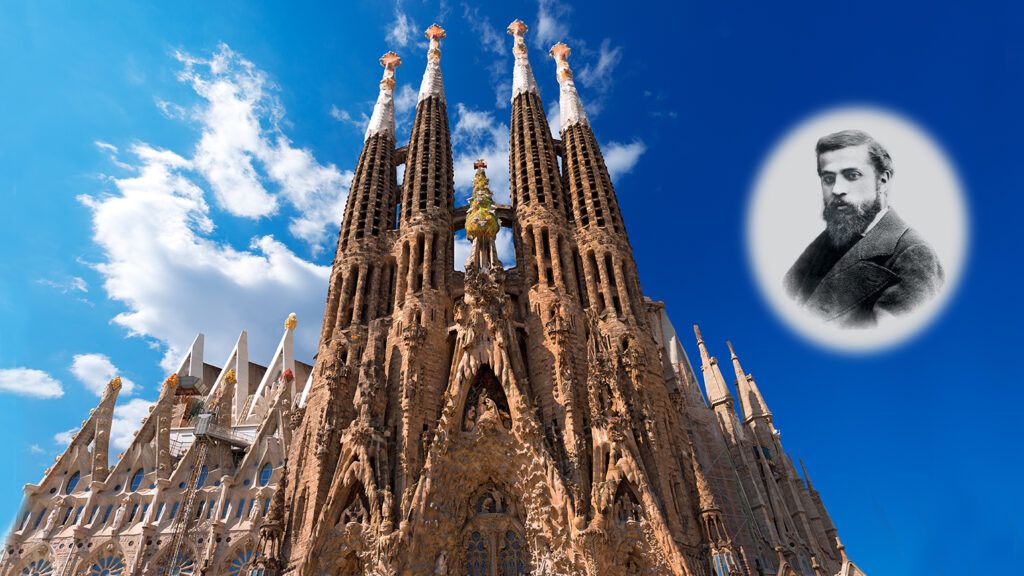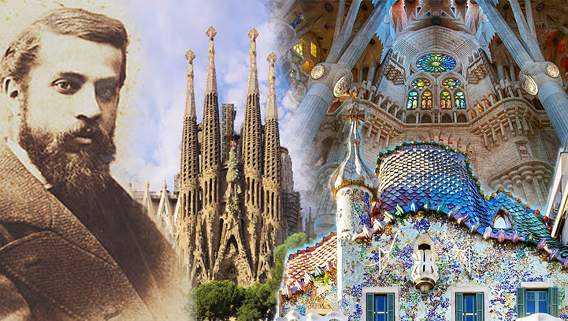The architect who designs buildings like sculptures: Who is Antoni Gaudi?
Catalan architect, the Spanish pioneer of the Art Nouveau movement, with his full name Antoni Plàcid Guillem Gaudi Cornet, commonly known as Antoni Gaudi.

He was born on June 25, 1852, in Tarragona, in the Catalonia region of Spain. His father is a copper master and his mother is the daughter of a copper master. Gaudi's childhood passed with diseases. He is a weak baby when he is born. As he grows, he deals with lung infection and rheumatism. Therefore, he has to spend a lot of time at home. This disadvantage of his develops his ability to observe and analyze the nature near his home, causing him to inspire his designs when he grows up. Gaudi designs buildings like sculptures by integrating the usual geometric forms of architecture with elements from nature. The fact that he sees buildings as artistic objects apart from their function distinguishes him from other architects.
Antoni Gaudí I Cornet (25 June 1852 – 10 June 1926) was a Spanish architect and designer from Catalonia, known as the greatest exponent of Catalan Modernism. Gaudí's works have a highly individualized, sui generis style. Most are located in Barcelona, including his main work, the church of the Sagrada Família.
In 1868, at the age of 17, he went to Barcelona with his older brother, who was studying medicine. After completing his primary education, he started studying architecture at the age of 22. Since the pre-university classes do not take much of his time, he visits the city and makes observations. Meanwhile, he is influenced by the Church of Santa Maria del Mer. According to Gaudi, this church is a symbol of ideal cooperation between public architecture and the community that will use it. Incorporating this relationship into his own style is one of the most important factors for the public acceptance of his later works.
Gaudi continues his student and working life together. He also organizes seminars and works in some local architectural offices. His ideas and perspective make him recognizable to other students. Although he is not a successful student, his solid modeling and sketches are admirable as well as attracting the attention of his teachers most of the time. Two of his first projects are deemed worthy of an exhibition by the faculty. He succeeded in his exam with the gate project he designed for a cemetery entrance in 1875 and was deemed worthy of the "extraordinary" title in his faculty.

One of the courses that attracted the most attention in the early years of architectural education was building statics. His experimental perspective on static problems, which contributed significantly to his professional identity, was evident during his school years. It is also possible that he failed his courses as a result of his interesting studies developed with this different perspective. So much so that the Dean of the Faculty will say when graduating Gaudi from school that they are "not sure whether they graduated a genius or a madman".
The interest and excitement in history can be perceived from the words "I felt myself in heaven" while examining the buildings of Gaudi, Roman, and Byzantine Periods. Not only that but after completing his education, he also takes courses in economics, aesthetics, and philosophy. He was also interested in many different fields; maritime, maritime military strategies, biology, and pharmacology are some of them.
In order to continue his architectural education, he works with different architects and while he is still a student, he takes part in important projects. While he was with the famous architect Josep Fontsere Mestres, he worked on the Ciutadella Park project, which has an important place in the identity of the city of Barcelona. Architect Joan Martorell i Montell was of great help to Gaudi during his youth, which was spent with difficulties and inexperience. A very religious and helpful person, Martorell sees all of Gaudi's pointed and unusual ideas. Martorell, who is 20 years older than Gaudi, opens many doors that are not open to everyone in the field of architecture Gaudi.
In these periods, Gaudi became an architect who was at the forefront of his political identity as well as his artistic identity. Barcelona, which has been used as a commercial center since Roman times, was an independent region from Spain. After it came under the rule of the Kingdom of Spain, many Catalan Republican communities formed in the city. Gaudi takes an active part in these communities. For this reason, it has a special place among the Catalans with its nationalist identity. He continues to speak the language during the periods when it is forbidden to speak Catalan. While his friend Torres Garcia considers himself "the most Catalan of the Catalans", he states that he is a folk hero as well as an artist. In this context, the Gothic style, which dominates the Catalan region and is active in Gaudi's work, is not only an aesthetic value but also plays a political symbol role in ensuring the continuity of the culture.
One of his first buildings, built between 1878 and 1888, was Casa Vicens, a residence built for the Vincent family, who owned a ceramics factory in Compillas, near Santander. This structure is one of the most dominant examples of the Umayyad Spanish synthesis, Mudejar style among Gaudi's works. Colorful ceramics and bricks were used on the façade. These elements, which are used in different colors and divisions, have given the façade an extremely active and colorful perception. Especially arches and minarets are fundamental to the perception of the Mudejar style. This colorfulness is perceived effectively in the interior as well.
One of the most important people who influenced Gaudi's professional identity is the Catalan businessman Eusebi Güell. Gaudi designed many of his known works for the Güell family. Eusebi Güell wants to see the glass unit that Gaudi designed to display the products of the Comella Ediven Factory at the Paris Fair and meet with its designer. Gaudi first met with the writings of art critic John Ruskin and architect William Morris, which influenced his professional identity, in Güell's library. These works, which he acquired during his business trips to England, enable Gaudi to perceive new perspectives in different countries.
Another important building built by Gaudi for the Güell family between 1900-1914 is Park Güell. Isabel Güell was impressed by the parks he saw during his visit to England and wanted to build such a park in Barcelona. Park Güell is one of the first indicators of the formation of Gaudi's original identity. In this park, there are organic, successive, and holistic forms perceived together, and the diversity is brought by the colorfulness of these forms. Three-dimensional volumetric formations are perceived by getting rid of the figurative and surface decorations of the Art Nouveau movement that imitate only nature.
The Sagrada Familia was designed as a discovery church by the founders of the Spiritual Society of Saint Joseph Devotees and is dedicated to Saint Joseph. The construction of the Sagrada Familia began in 1882 by the architect Francisco de Paula del Villar y Lozano. Gaudi took over in 1883 and was involved in design and construction until his death in 1926. The construction of the building still continues in line with Gaudi's designs.
We can understand that the church is one of the greatest monuments of Christian symbolism from the 3 important facades that Gaudi gave to the church. Symbolizing the birth of Jesus, the Nativity Façade faces east and also emphasizes the sunrise; The Death Façade, symbolizing the death of Jesus, faces west and also highlights the sunset; The Life and Glory façade in the south, the Life/Glory Façade, tells religious stories that glorify life and these stories are enriched with a wide variety of symbols.
As a result of observing his father, who was a coppersmith in his childhood, it can be said that the curved shapes of the alembics he made to distill the alcohols of the grapes and the distorted shapes of the copper cauldrons formed the basis of Gaudi's design philosophy. This experience helps him develop his thoughts on the concepts of space and space. Gaudi also researches Andalusian, Indian and Egyptian arts and reflects them in some of his works.
The diversity of the areas in which it is located is effective in the formation of the identity of the architect. Another factor affecting Gaudi's artistic identity is the Arabian architecture, especially the decorations of the Andalusian Umayyads, who were active in Spain for a while. This style, called Müdejar, was the architectural and formal traces left by the Andalusian Umayyad State on the Spanish territory. In this style, there were intense influences from the Arabian architectural ornamentation style. In particular, the use of geometric ornaments and tiles can be given as examples of these effects. This synthesis was created by the Arabs living on the territory of Spain; The association system of geometric ornaments, arches, dome decorations with stalactites, facades, and minarets are the aesthetic values that influenced Gaudi and the elements he used in his works.
Gaudi was a very religious artist. Religious elements are also reflected in the works of a spiritual atmosphere. Towards the end of his life, this effect begins to be felt even more. In fact, he almost loses his life because of the fast he keeps.
Gaudi is often portrayed as an asocial and unpleasant, grumpy, arrogant man. However, his relatives describe him as gentle and kind, pleasant to talk to, and honest.
Gaudi set out to go to the church of Sant Felip Neri on June 7, 1926. While walking absentmindedly along the Gran Via de las Cortes Catalanes, between Girona and Baylen streets, a tram crashes into Gaudi and he loses consciousness. Taxi drivers refuse to take a messy, unrecognizable old man with no money and no papers to the hospital, for fear of not being paid for the ride. Nevertheless, Gaudi is taken to a hospital for the poor, where he receives only primitive medical care. He is found and identified by the priest the next day. But it was too late; Gaudi's condition worsens; He died on June 10, 1926.
